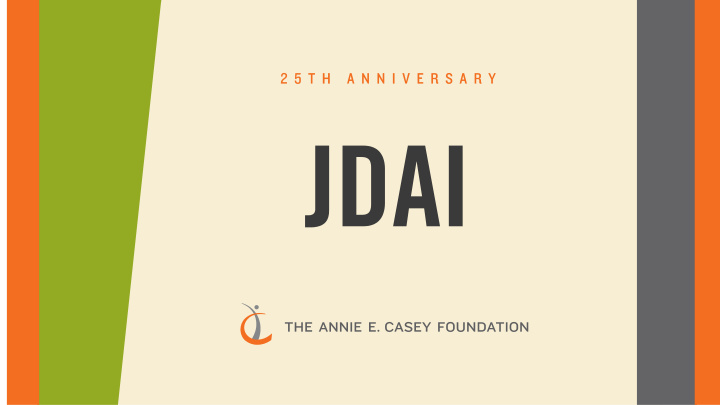



1
The Juvenile Detention Alternatives Initiative (JDAI) was conceived to address what had become a national crisis in the early 1990s Detention populations were climbing, with far But, JDAI was also created as an entry- too many youth in over-crowded facilities point strategy for deeper system reform AVERAGE DAILY POP OF JUVENILES IN U.S. U.S. ADJUDICATION & PLACEMENT RATES: PUBLIC DETENTION CENTERS (1985-1995) DETAINED YOUTH VS. NOT DETAINED YOUTH 25,000 70% 20,000 60% 58% 53% 50% 15,000 47% 40% 39% 10,000 30% 24% 24% 5,000 20% 18% 21% 0 10% 1985 1987 1989 1991 1993 1995 0% 1992 2010 PERCENTAGE OF JUVENILES IN OVERCROWDED U.S. PUBLIC DETENTION CENTERS (1985-1995) Detained: % Adjudicated 20% 31% 42% 47% 50% 60% Detained: % Adjudicated that were placed Not Detained: % Adjudicated Not Detained: % Adjudicated that were placed Detained youth are more than twice as likely to be adjudicated and placed. 1985 1987 1989 1991 1993 1995 Nationally, this has changed little over time
JDAI uses eight interconnected strategies to enable jurisdictions to safely reduce reliance on secure detention CORE STRATEGIES: PURPOSE: To demonstrate that jurisdictions Collaboration can establish more effective and efficient systems to accomplish Use of accurate data the purposes of juvenile detention. Objective admissions criteria and OBJECTIVES: instruments 1) Eliminate inappropriate or unnecessary use of secure Alternative to detention detention 2) Minimize failures to appear and Case processing reforms incidence of delinquent behavior Reducing the use of secure 3) Redirect public finances to confinement for ‘special’ cases successful reform strategies Deliberate commitment to reducing 4) Improve conditions in secure racial disparities detention facilities 5) Reduce racial and ethnic Improving conditions of disparities confinement
Results • 43 percent drop in average daily detention population • 1.4 million fewer days in detention • 90,000 fewer admissions annually • 57 percent drop in commitments to state custody
The Missouri Story ALL Youth Youth Of Color ADP Down 65% Down 64% Admissions Down 59% Down 47% ALOS UP 23% UP19% Commitments Down 28% Down 32% Public Safety Indicator Down 28% Juvenile Referrals/Intake Cases 5
JDAI is active in more than 300 counties, spanning 39 states, the District of Columbia and two Tribes ME WA MT NH MN NY MA OR WI SD RI ID WY PA NJ IA DE NE IN OH CA MD NV IL DC VA KY KS MO TN NM AZ AR State site AL GA Tribal site MS TX County site LA Model site FL HI PR One in four youth live in a community that participates in JDAI. 6
JDAI Forward Opportunities Length of Stay Advancing Equity Replacing Youth Prisons Expanding Partnerships Connecting the Network
Lengths of stay Change from Change from 18% -11% -14% -27% -33% -40% Admissions ALOS ADP
JDAI Forward Opportunities Length of Stay Advancing Equity Replacing Youth Prisons Expanding Partnerships Probation Transformation Connecting the Network
Advancing Equity: 2016 detention rate per 100,000 youth Youth of Color detained at more than three times the rate of white youth 83 23 White Non-Hispanic Youth Youth of Color
Our Focus on Equity Our Focus Shared language Structural barriers Targeted strategies
JDAI Forward Opportunities Length of Stay Advancing Equity Replacing Youth Prisons Expanding Partnerships Connecting the Network
Grounding Principles: What Kind of Juvenile Justice System? To grow, system involved youth need … … a sense of safety Youth need to feel safe in their environment, and they need a sense of physical and emotional well-being. … a sense of Youth need to feel connected to positive adults and positive peers connection … a sense of purpose Youth need to have goals to strive toward , skills to hone, and a sense that they have a valuable role to play in the lives of the people and the community around them. … a sense of fairness Youth need to perceive delinquency proceedings to be fair and transparent and sanctions imposed to themselves and their peers to be proportionate to the offense. A juvenile justice system that was truly built to promote desistance and reduce recidivism would focus its resources and attention on meeting those developmental needs, and would stop doing anything that stands in the way of that goal.
JDAI Forward Opportunities Length of Stay Advancing Equity Replacing Youth Prisons Expanding Partnerships Connecting the Network
Get Connected! Your Voices are Needed jdaiconnect.org
To get connected----- • Go to www.jdaiconnect.org • Click on “Non - Casey Staff Login”
JDAI Forward Opportunities Length of Stay Advancing Equity Replacing Youth Prisons Connecting the Network Expanding Partnerships
These are Our Children
Recommend
More recommend